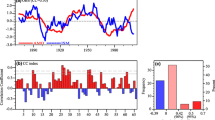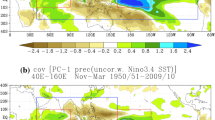Abstract
A set of 12 state-of-the-art coupled ocean-atmosphere general circulation models (OAGCMs) is explored to assess their ability to simulate the main teleconnections between the West African monsoon (WAM) and the tropical sea surface temperatures (SSTs) at the interannual to multi-decadal time scales. Such teleconnections are indeed responsible for the main modes of precipitation variability observed over West Africa and represent an interesting benchmark for the models that have contributed to the fourth Assessment Report of the Intergovernmental Panel on Climate Change (IPCC4). The evaluation is based on a maximum covariance analysis (MCA) applied on tropical SSTs and WAM rainfall. To distinguish between interannual and multi-decadal variability, all datasets are partitioned into low-frequency (LF) and high-frequency (HF) components prior to analysis. First applied to HF observations, the MCA reveals two major teleconnections. The first mode highlights the strong influence of the El Niño Southern Oscillation (ENSO). The second mode reveals a relationship between the SST in the Gulf of Guinea and the northward migration of the monsoon rainbelt over the West African continent. When applied to HF outputs of the twentieth century IPCC4 simulations, the MCA provides heterogeneous results. Most simulations show a single dominant Pacific teleconnection, which is, however, of the wrong sign for half of the models. Only one model shows a significant second mode, emphasizing the OAGCMs’ difficulty in simulating the response of the African rainbelt to Atlantic SST anomalies that are not synchronous with Pacific anomalies. The LF modulation of these HF teleconnections is then explored through running correlations between expansion coefficients (ECs) for SSTs and precipitation. The observed time series indicate that both Pacific and Atlantic teleconnections get stronger during the twentieth century. The IPCC4 simulations of the twentieth and twenty-first centuries do not show any significant change in the pattern of the teleconnections, but the dominant ENSO teleconnection also exhibits a significant strengthening, thereby suggesting that the observed trend could be partly a response to the anthropogenic forcing. Finally, the MCA is also applied to the LF data. The first observed mode reveals a well-known inter-hemispheric SST pattern that is strongly related to the multi-decadal variability of the WAM rainfall dominated by the severe drying trend from the 1950s to the 1980s. Whereas recent studies suggest that this drying could be partly caused by anthropogenic forcings, only 5 among the 12 IPCC4 models capture some features of this LF coupled mode. This result suggests the need for a more detailed validation of the WAM variability, including a dynamical interpretation of the SST–rainfall relationships.














Similar content being viewed by others
References
Bader J, Latif M (2003) The impact of decadal-scale Indian Ocean sea surface temperature anomalies on Sahelian rainfall and the North Atlantic oscillation. Geophys Res Lett 30:2169. DOI 10.1029/2003GL018426
Biasutti M, Giannini A (2006) Robust Sahel drying in response to late 20th century forcings. Geophys Res Lett 33:L11706. DOI 10.1029/2006GL026067
Bretherton CS, Smith C, Wallace JM (1992) An intercomparison of methods for finding coupled patterns in climate data. J Clim 5:541–560
Camberlin P, Chauvin F, Douville H, Zhao Y (2004) Simulated ENSO-tropical rainfall teleconnections in present-day and under enhanced greenhouse gases conditions. Clim Dyn 23:641–657
Charney JG (1975) Dynamics of deserts and drought in the Sahel. Q J R Meteorol Soc 428:193–202
Cheng X, Dunkerton TJ (1995) Orthogonal rotation of spatial patterns derived from singular value decomposition analysis. J Clim 8:2631–2643
Deser C, Phillips AS, Hurrell JW (2004) Pacific interdecadal climate variability: linkages between the tropics and the North Pacific during boreal winter since 1900. J Clim 17:3109–3124
Diaz HF, Hoerling MP, Eischeid JK (2001) ENSO variability, teleconnections and climate change. Int J Climatol 21:1845–1862
Douville H (2005) Limitations of time-slice experiments for predicting regional climate change over South Asia. Clim Dyn 24:373–391
Douville H, Salas-Mélia D, Tyteca S (2006a) On the tropical origin of uncertainties in the global land precipitation response to global warming. Clim Dyn 26:367–385
Douville H, Conil S, Tyteca S, Voldoire A (2006b) Soil moisture memory and West African monsoon predictability: artefact or reality? Clim Dyn (submitted)
Fedorov AV, Philander SG (2001) A stability analysis of tropical ocean-atmosphere interactions: bridging measurements and theory for El Niño. J Clim 14:3086–3101
Folland CK, Palmer TN, Parker DE (1986) Sahel rainfall and worldwide sea temperatures. Nature 320:602–607
Fontaine B, Janicot S (1996) Sea surface temperature fields associated with West African rainfall anomaly types. J Clim 9:2935–2940
Fu X, Wang B, Li T (2002) Impacts of air–sea coupling on the simulation of mean Asian summer monsoon in the ECHAM4 model. Mon Weather Rev 130:1889–2904
Ghil M, Allen MR, Dettinger MD, Ide K, Kondrashov D, Mann ME, Robertson AW, Saunders A, Tian Y, Varadi F, Yiou P (2002) Advanced spectral methods for climatic time series. Rev Geophys 40:3–1
Giannini A, Saravanan R, Chang P (2005) Dynamics of the boreal summer African monsoon in the NSIPP1 atmospheric model. Clim Dyn 25:517–535
Guilyardi E (2006) El Niño—mean state—seasonal cycle interactions in a multi-model ensemble. Clim Dyn 26:329–348
Held IM, Delworth TL, Lu J, Findell KL, Knutson TR (2005) Simulation of Sahel drought in the 20th and 21st centuries. PNAS 102:17891–17896
Janicot S (1992) Spatiotemporal variability of West African rainfall. Part II: associated surface and airmass characteristics. J Clim 5:499–511
Janicot S, Moron V, Fontaine B (1996) Sahel droughts and ENSO dynamics. Geophys Res Lett 23:515–518. DOI 10.1029/96GL00246
Janicot S, Trzaska S, Poccard I (2001) Summer Sahel-ENSO teleconnection and decadal time scale SST variations. Clim Dyn 18:303–320
Koster RD, the GLACE team (2004) Regions of strong coupling between soil moisture and precipitation. Science 305:1138–1141
Krishna Kumar K, Hoerling M, Rajagopalan B (2005) Advancing dynamical prediction of Indian monsoon rainfall. Geophys Res Lett 32:L8704. DOI 10.1029/2004GL021979
Lamb PJ (1978) Case studies of tropical Atlantic surface circulation patterns during recent sub-saharan weather anomalies: 1967 and 1968. Mon Weather Rev 106:482–491
Lau KM, Shen SSP, Kim KM, Wang H (2006) A multimodel study of the twentieth-century simulations of Sahel drought from the 1970s to 1990s. J Geophys Res (Atmospheres) 111:D071111. DOI 10.1029/2005JD006281
Lu J, Delworth TL (2005) Oceanic forcing of the late 20th century Sahel drought. Geophys Res Lett 32:L22706. DOI 10.1029/2005GL023316
Mann ME, Lees JM (1996) Robust estimation of background noise and signal detection in climatic time series. Clim Change 33:409–445
Moron V, Philippon N, Fontaine B (2003) Skill of Sahel rainfall variability in four atmospheric GCMs forced by prescribed SST. Geophys Res Lett 30:2221. DOI 10.1029/2003GL018006
Moron V, Philippon N, Fontaine B (2004) Simulation of West African monsoon circulation in four atmospheric general circulation models forced by prescribed sea surface temperature. J Geophys Res (Atmospheres) 109:D24105. DOI 10.1029/2004DJ004760
New M, Hulme M, Jones P (2000) Representing twentieth-century space-time climate variability. Part II: development of 1901–96 monthly grids of terrestrial surface climate. J Clim 13:2217–2238
Paeth H, Friederichs P (2004) Seasonality and time scales in the relationship between global SST and African rainfall. Clim Dyn 23:815–837
Peña M, Kalnay E, Cai M (2003) Statistics of locally coupled ocean and atmosphere intraseasonal anomalies in reanalysis and AMIP data. Nonlinear Processes Geophys 10:245–251
Rayner NA, Parker DE, Horton EB, Folland CK, Alexander LV, Rowell DP, Kent EC, Kaplan A (2003) Global analyses of sea surface temperature, sea ice, and night marine air temperature since the late nineteenth century. J Geophys Res (Atmospheres) 108:4407. DOI 10.1029/2002JD002670
Rotstayn LD, Lohmann U (2002) Tropical rainfall trends and the indirect aerosol effect. J Clim 15:2103–2116
Rowell DP (2001) Teleconnections between the tropical Pacific and the Sahel. Q J R Meteorol Soc 127:1683–1706
Rowell DP (2003) The impact of Mediterranean SSTs on the Sahelian rainfall season. J Clim 16:849–862
Rowell DP, Folland CK, Maskell K, Ward NM (1995) Variability of summer rainfall over tropical north Africa (1906-92): observations and modelling. Q J R Meteorol Soc 121:669–704
Van Oldenborgh GJ, Burgers G (2005) Searching for decadal variations in ENSO precipitation teleconnections. Geophys Res Lett 32:L15701. DOI 10.1029/2005GL023110
Van Oldenborgh GJ, Philip S, Collins M (2005) El Niño in a changing climate: a multi-model study. Ocean Sci Discuss 2:267–298
Von Storch H, Zwiers FW (1999) Statistical analysis in climate research. Cambridge University Press, London
Wallace JM, Lim GH, Blackmon ML (1988) Relationship between cyclone tracks, anticyclone tracks and baroclinic waveguides. J Atmos Sci 45:439–462
Wallace JM, Smith C, Bretherton CS (1992) Singular value decomposition of wintertime sea surface temperature and 500-mb height anomalies. J Clim 5:561–576
Ward MN (1998) Diagnosis and short-lead time prediction of summer rainfall in tropical North Africa at interannual and multidecadal timescales. J Clim 11:3167–3191
Wilks DS (1997) Resampling hypothesis tests for autocorrelated fields. J Clim 10:65–82
Acknowledgments
This work was supported by the AMMA program (African Monsoon Multidisciplinary Analysis), and by the ENSEMBLES European project (contract GOCE-CT-2003-505539). The authors are grateful to all IPCC4 participants and to the PCMDI for the build up of the IPCC4 database. The figures have been prepared using GrADS software, and the MTM tool was found on the Web site http://www.atmos.ucla.edu/tcd/ssa/. Thanks are also due to Fabrice Chauvin for his comments, and Serge Janicot for improving the original manuscript. Finally, we acknowledge the two anonymous reviewers for their constructive criticisms and suggestions.
Author information
Authors and Affiliations
Corresponding author
Rights and permissions
About this article
Cite this article
Joly, M., Voldoire, A., Douville, H. et al. African monsoon teleconnections with tropical SSTs: validation and evolution in a set of IPCC4 simulations. Clim Dyn 29, 1–20 (2007). https://doi.org/10.1007/s00382-006-0215-8
Received:
Accepted:
Published:
Issue Date:
DOI: https://doi.org/10.1007/s00382-006-0215-8




